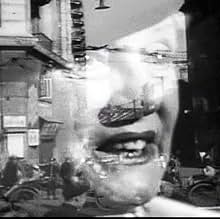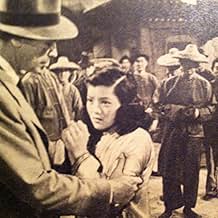अपनी भाषा में प्लॉट जोड़ेंAfter witnessing an incident on a foreign ship off California coast, a U.S. Treasury agent aboard a Coast Guard vessel decides to further investigate the matter by following a crime trail le... सभी पढ़ेंAfter witnessing an incident on a foreign ship off California coast, a U.S. Treasury agent aboard a Coast Guard vessel decides to further investigate the matter by following a crime trail leading to China, Egypt, Lebanon and Cuba.After witnessing an incident on a foreign ship off California coast, a U.S. Treasury agent aboard a Coast Guard vessel decides to further investigate the matter by following a crime trail leading to China, Egypt, Lebanon and Cuba.
- पुरस्कार
- 2 जीत और कुल 1 नामांकन
- Ensign
- (बिना क्रेडिट के)
- Ship's Officer
- (बिना क्रेडिट के)
- Joe
- (बिना क्रेडिट के)
- Treasury Agent in Ship's Galley
- (बिना क्रेडिट के)
- Ship's Officer
- (बिना क्रेडिट के)
- Midgie
- (बिना क्रेडिट के)
- Ship Passenger
- (बिना क्रेडिट के)
फ़ीचर्ड समीक्षाएं
So, who's the man behind the illegal operation? Well, for one thing, we know he's an agent of imperial Japan (circa,1935) since their army seeks to pacify a conquered Manchuria with loads of the deadening drug—(note: I wish the prologue stated whether this wicked scheme is actual historical fact or not). Anyhow, the premise provides employment opportunity for a host of Hollywood's shady characters, including Hoyt, Hasso, and two favorite Nazis, Triesault and Donath. So there's intrigue a-plenty.
However, I'm not sure I buy the last leg of the smuggling operation since it seems so risky, depending as it does on exact timing in a big ocean. Nonetheless, the various ruses are cleverly conceived, although at times the various in's and out's may be a little hard to follow. And you may need a scorecard to keep up with the shifting cast of characters. But that early scene of jettisoning illegal cargo is one-of-a-kind and about as cold-blooded as any film of that era.
(In passing-- a recurring theme is international cooperation in behalf of mankind, while the final shot is an optimistic one of the United Nations building. A year later, and I suspect the menace would have shifted to the Soviets with a much darker outlook.) Still and all, this is one of the best docu-dramas from a time when Hollywood appeared to be doing gratis pr work for the feds.
Strangely neglected film, probably because its view of the international drug trade seems rather quaint by today's standards. Still, a wonderful time capsule that reminds us of such forgotten history as Japan's wartime domination of China and the crumbling colonial empires of England and France in the Middle East. Also, the slave trade theme continues (sadly) to resonate, given the recent headlines about Chinese workers being smuggled into the States as sweatshop laborers.
Hate reviews that give away stuff, and I don't mean just give away the important stuff, I mean give away anything. Totally stubborn about that, more than anyone I know. Sorry, not gonna say anything about this plot except that the title sums it up well enough. Much better than most 40s-50s international intrigue BS like "Beat the Devil" or "Rope of Sand". If you can slog through that crap you need to watch this.
Most everything I watch these days are old crime thrillers, and as much as I enjoy them, a lot don't hold up well over time. This is an exception, no question. I hardly ever write reviews here - honestly, I don't even know if I've even done one, that's how much I care about putting them down. Felt compelled to in this case.
The film is narrated by Powell and this Columbia film is very similar in style to those 20th Century Fox documentary classics The House On 92nd Street and The Street With No Name from Henry Hathaway. The director is Robert Stevenson who is far more familiar to viewers for his later exclusive work for Walt Disney studios in such things as Old Yeller and Mary Poppins. You can hardly believe the same guy directed those items as well as To The Ends Of The Earth.
Powell almost circumnavigates the globe, starting out in San Francisco and then going to Shanghai, Cairo, Beirut, Havana, and finally New York in pursuit of an international narcotics smuggling gang. The story takes place in the pre-World War II years while Japan occupied Manchuria. The most ridiculous part of the film is the notion that the Japanese are behind the opium trade as part of their war policy though the gang is certainly international enough.
What makes the film relevant for today is the plea for international cooperation to put an end to the drug trade. In fact this film was one of the to even talk about drug addiction, a problem not mentionable under The Code. Opium dependence knows no borders, respects no nationalities.
The film will also have a surprise ending that you might not expect coming. The only hint is a bit showing a portrait of who turns out to be the chief villain. The artist's interpretation of said villain screams out who's behind it all.
Powell gets good support from Signe Hasso, Ludwig Donath, Vladimir Sokoloff and Maylia in telling roles. To The Ends Of The Earth is one of the best films Dick Powell made in his post musical period, don't miss it if you can.
But in the late 1940s, two films took on the phenomenon directly: Port of New York and To The Ends of the Earth. Both films show the stridency that would soon come to be characteristic of the Red Scare films of the early 1950s. Port of New York, however, effectively explored its noirish milieu, while To The Ends of the Earth harks back to the international espionage pictures of wartime and the pre-war years.
Treasury agent Dick Powell witnesses the mass death of Asian `slaves,' jettisoned overboard in chains from a Japanese freighter off the coast of San Francisco. Soon, in relentless pursuit of the opium poppy, Papaver somniferum, he circles the globe from Shanghai to Egypt to Cuba and finally to New York. His travels curiously intertwine with those of an American widow (Signe Hasso) and her young Chinese ward (Maylia). He uncovers a ruthless (`fanatical' is the preferred adjective) worldwide conspiracy to grow, distribute and sell opium, ultimately refined into heroin. The case doesn't crack until his ocean liner begins entry into New York harbor.
It's a good-bad movie. One of the burdens the noir cycle occasionally had to shoulder was paying homage to various principalities and duchies of the U.S. Government, generally J. Edgar Hoover's Federal Bureau of Investigation (as in Call Northside 777) or the Treasury Department (as in T-Men). Here, it's the Narcotics Bureau headed by Harry Anslinger, who graces the movie with his presence in three cameos. The requisite tone of reverence is anathema to noir, and Powell's voice-over narration drones on and on, a powerful opiate in itself.
But the nuts and bolts of the drug trade operated by a global cartel retain surprising interest, and the movie's pace picks up as it progresses, right up to a fairly shocking twist at the end. Many of its attitudes and assumptions show their age, but To The Ends of the Earth ultimately delivers its product.
क्या आपको पता है
- ट्रिविया"Lux Radio Theater" broadcast a 60 minute radio adaptation of the movie on May 23, 1949 with Dick Powell and Signe Hasso reprising their film roles.
- भाव
Nicholas Sokim: [dying] Your American friend is puzzled. Explain to him what happens when bamboo slivers are rolled up in food. Poke into your gut...
टॉप पसंद
- How long is To the Ends of the Earth?Alexa द्वारा संचालित
विवरण
- रिलीज़ की तारीख़
- कंट्री ऑफ़ ओरिजिन
- आधिकारिक साइटें
- भाषा
- इस रूप में भी जाना जाता है
- Assigned to Treasury
- फ़िल्माने की जगहें
- हवाना, क्यूबा(background footage)
- उत्पादन कंपनियां
- IMDbPro पर और कंपनी क्रेडिट देखें
बॉक्स ऑफ़िस
- बजट
- $20,00,000(अनुमानित)
- चलने की अवधि1 घंटा 49 मिनट
- रंग
- पक्ष अनुपात
- 1.37 : 1
इस पेज में योगदान दें































